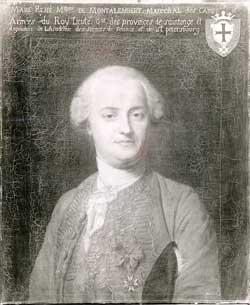Marc Montalembert

Marc René of Montalembert was born at the end of Louis XIV's reign in Angoulême, on the 15th July 1714. Born into an ancient and noble family from Poitou, he was betrothed by birth to the pursuit of arms and chose a military career. He distinguished himself during the Austrian war of succession, and in 1742 became captain of the Prince of Conti's guards. After becoming academician of the Sciences in 1747, he was noticed by the Duke of Choiseul who gave him the mission of seconding the Swedish and Russian army generals during the 7-years war, during which he commanded the operations in Pomerania. He became field marshal in 1761, subsequently serving in Brittany, whilst at the same time preparing a work dedicated to the art of fortification.
In fact, the last years of the Ancien Régime were marked by a period of relative opposition to change in military architecture. Although Cormontaigne can be considered as one of the heirs of Vauban, the designs of Marc René de Montalembert are radically opposed to those of the famous Marshal. A trained artilleryman, he preferred the Vauban principles of concentrated fortification, attacking the enemy with concentrated firepower served by numerous cannons, that were ever more accurate as well as more powerful. He was thus responsible for creating numerous cannon foundries in France, including the Ruelle forges, near his birthplace. Taking inspiration from the restructuring of the artillery orchestrated by the Lieutenant-General of Gribeauval, the Marquis of Montalembert advocated making the cannon the front line of defence, rather than the rifle preferred by the former general commissioner for the fortifications of Louis XIV's reign. Between 1776 and 1794, he published the eleven volumes of his major work, "perpendicular fortification, or defensive art over offensive art". Convinced of the need to adapt the fortifications to new developments in firearms, Marc René de Montalembert recommended placing the combat zones further away from the central fortresses themselves, and broke away from the sharp angles and recesses that characterised the bastions and curtain-walls built by Vauban. He was something of a pioneer, calling for the advent of fortresses built in a polygonal layout, reinforced with cannon towers and caponiers, but stripped of advanced defence fortifications. The architectural layout put forward by the Marquis of Montalembert consisted of several forts positioned side by side, directly facing the enemy. His theories were virtually ignored in France during his lifetime. The short-lived fortress erected in 1779 on the site of the fort de la Rade (Island of Aix) was one of the only examples of defensive edifices built by the Marquis. This fortress, with its triple casemate firing levels was destroyed however in 1783. It was not until the XIXth century that other forts were built based on the principles decreed by the Marquis of Montalembert, including fort Boyard off the coast of the Island of Aix, and the fortress of La Ferrière in Haïti. The perpendicular fortification had more success with foreign military engineers, in particular, the Austro-Sardinians. The fortified site of Esseillon is therefore a remarkable example of the architectural ideas of Marc René of Montalembert put into practice. Among the forts which make up this impressive fortified barrier, the Marie-Christine fort is without doubt the most characteristic of the Marquis' innovative designs: this regular hexagon built in 1819 enabled concentrated perpendicular artillery fire within a restricted space. Condemned during the Revolution having never seen his theories on military architecture put into practice, Marc René of Montalembert died on the 26th March 1800 in Paris.

